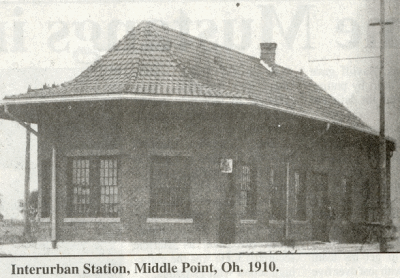
Window to the Past
Interurban (traction line) comes to Delphos
By BOB HOLDGREVE
The first Interurban car ran through Delphos on Nov. 1, 1905, while the last car to run on the line through town was June 30, 1932.
This 65 mile line ran from Lima to Ft. Wayne, Ind. It was a fast route, entirely on private-right-of-way except for short stretches on city streets in larger towns. From Lima, the trolley ran on the north side of the Pennsylvania railroad to Delphos, where they came in on East Second Street and ran down the center of the street. Leaving town on the west end, it crossed over the Pennsy on the "overhead," and ran along its south shoulder to Middlepoint Road, which it paralleled on the south side. It perked up Ohio 116 running on the south edge into Van Wert. There it rumbled down Main Street then running north back to the Pennsy, and then ran on its south side, through Convoy.
At sunrise on Easter Sunday - March 27, 1910, the "Convoy Horror," as it was called for years, struck tragedy on the line.
Car 82, westbound, pulled into Van Wert as Easter church bells were chiming. At the depot, train dispatcher, Van Scoy, handed a train order to Motorman Oscar Stewart and Conductor R.C. Treastor, which ordered them to pull into a siding at Convoy, and wait for express Car 199, an extra on the line.
This was not done. After passing the station in Convoy, Car 82 rounded a curve at 6:41 a.m. and rammed head-on into 199. J. Pearl Pheron of Lima, motorman on the express messenger of Lima was roasted to death under the flaming debris. James Risk, assistant express messenger, suffered a broken leg and internal injuries. Seven passengers of 82 were shaken up, but Stewart and Treastor came out unscathed. The express car was demolished, and the passenger car suffered fatal damage.
Two weeks later, the Van Wert County Coroner found Treastor and Stewart guilty of gross negligence and carelessness. This was just one of many such tragedies that occurred on the single track interurbans.
The depot in Lima was located on the public square and a car barn was located on the southwest corner of Grand Ave. and North Main St. While in Delphos, the depot was located on East Second St., where WDOH radio station is now. There was a siding leading to a loading dock across the street, next to the alley where Community First drive-in bank is now located.
In Middle Point, the depot was on Middlepoint Road on the south edge of town. The building is still there and has been abandoned for years.
At Van Wert, the depot was located at the Marsh Hotel on Main Street, and later was moved to Main and Cherry streets, at the site of what was later the Diesel-Wemmer-Gilbert tobacco plant office.
At Convoy, the depot appeared to be identical to the Middle Point depot.
It cost 15 cents to ride from Delphos to Van Wert and Lima and $1.50 to ride the full 165 miles between Lima and Ft. Wayne.
If you were at a rural crossing at night and wanted the trolley to stop, you would light a match to a newspaper and the conductor would see it and stop.
One time, an interurban passenger asked the conductor if the car would stop at the next crossing? He replied, "Lady, if necessary we will stop twice at a double house."
At one period, Van Wert was voted, "dry," while Delphos was "wet," or allowed to sell alcoholic beverages. On the weekends, some of the cars would carry people coming from Van Wert to Delphos, and on their return home they would carry containers full of beverages, and they would be full also.
J. S. Moulton stated that while riding the Ohio Electric car from Lima to Ft. Wayne, at Van Wert, the Manhattan Limited on the Pennsy Railroad, which parallels the traction line, came up, but we passed the steam train and kept ahead of it.
On straight stretches, an interurban car could reach 80 miles-per-hour. Some of the 45 ton cars were powered by four 150 H.P. electric motors from overhead electric wires.
Among the luxury features in most trolley cars were electrically heated curling irons in the ladies toilet, electric fans in the main compartment, and electric cigar lighters in the men's smoking room.
The service between Lima and Ft. Wayne consisted mainly of two classes, local and limited. The local trains catered mainly to people traveling to and from the country, these trains making stops any time they were signaled. Limited trains made city and town stops only. Special cars would be operated between any two points, for a guarantee of 50 adult fares.
In March 1906, the Lima and Toledo Traction Company leased the Ft. Wayne-Lima route. In May 1907, the Ohio electric purchased the Lima-Toledo, thereby acquiring its lease interest in the Lima-Ft. Wayne. Ohio Electric continued to manage the line until 1921, when it reverted back to its original owners: Ft. Wayne, Van Wert and Lima Traction Co. In October 1926, the line was sold at bankruptcy auction for $150,000 to virtually the same owners. It was then renamed the Ft. Wayne-Lima Railroad.
In 1930, the Indiana Railroad took it over. A feeble attempt to fight the automobile was a plea in the last timetable, "With 3 cents a mile trolley fares, can you drive your car for that?" The last car went through Delphos on June 30, 1932. The cars were too nice to scrap and were sold to the Oklahoma Railway. They ran with other Ohio cars there, until 1947 when that system was scrapped.
Information from - Ohio Trolly Trails by Harry Christiansen and History of Van Wert County by O'daffer.
(Continued next month.)

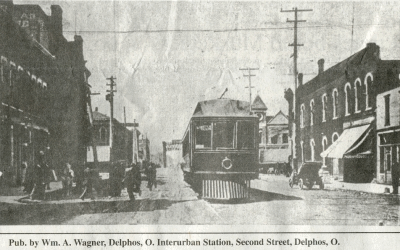

Compiled by Robert Holdgreve
Delphos Historical Society
January 18, 2003 Delphos Herald Newspaper
Cities capitalize on Interurban
capabilities
Part 2
By BOB HOLDGREVE
At one time, after the interurban closed, the Middle Point Depot housed the Crawford Plymouth-Desota dealership. Later on McGinnis had a machinery repair shop there.
According to the rules of the road, eastbound trains had the right-of-way and there were sidings at certain places when trains could pass. One was one-quarter mile west of Convoy, while another was located between Middle Point and Delphos.
Most of the cars had a baggage and freight compartment. There were some strictly freight cars. At most, a trolley car might pull two more cars.
Lodges, clubs, churches and other groups often chartered a car for outings.
Practically all interurbans were standard gauge, which means the rails were 56 1/2 inches apart.
In 1905, the Dayton, Springfield and Urbana prided itself on its ability to move horses on the cars with passengers using the front baggage compartment.
The D.S. & U. won national fame the same year when it worked out an owl newspaper delivery service with the Dayton Journal. The daily discovered that the roads were too muddy and rutty for dependable trucking of newspapers so it bought an Oldsmobile truck, (remember this was 1905), and attached railroad wheels to it. Papers were loaded on this truck and departed Dayton at 3:30 a.m. A motorman was taught how to drive the Oldsmobile, and rushed the papers to Springfield. Enroute, papers were hurled off at way stations, at Dead Man's Crossing, Harshman and Osborn. In downtown Springfield, 15 carrier kids met the truck and the remaining paper were transferred to other interurbans for early dawn runs to other towns. Record for the run was 48 minutes, with the makeshift truck hitting 50 m.p.h. often on its journey.
If you come across a postcard showing an interurban car on a track in Kenton, you have a very good collector's item, as Kenton never had an interurban. They chartered a company in 1903, and the company laid 2.5 miles of track in Detroit Street. Money ran out and the company never was able to find more money. After the track was installed, Kenton was jubilant about the prospect of trolley cars coming to town. Postcards were issued showing trolleys superimposed on the track. Residents sent them to friends in distant cities, proud that Kenton could boast of trolley cars.
After the C.H. & D. and other lines were bought out, a new company was formed - the Cincinnati & Lake Erie R.R. They bought some new plush, lightweight cars christened "Red Devils". There coaches could actually reach 96 m.p.h. A race was staged between Car No. 122 and an open cockpit biplane, with the car winning after hitting 97 m.p.h. After this, the cameramen packed up and went to a straightway near Lafayette, where No. 122 challenged an Indianapolis Speedway race car. No. 122 won easily.
The first interurban in Ohio was started at Newark in 1889. The early interurbans were an extension of city horse-drawn car lines, into the countryside to another town. Along the rural stops were little shanties and platforms where farmers loaded milk, produce and poultry. Freight cars came frequently to collect this merchandise and at night would return and deposit the empty milk cans and chicken crates.
The 217 mile Cincinnati-Toledo main line was the longest through trolley run in the United States for years
Information from Ohio Trolley Trails by Harry Christiansen.
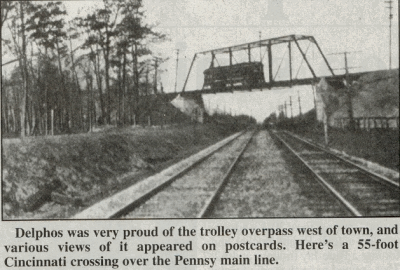
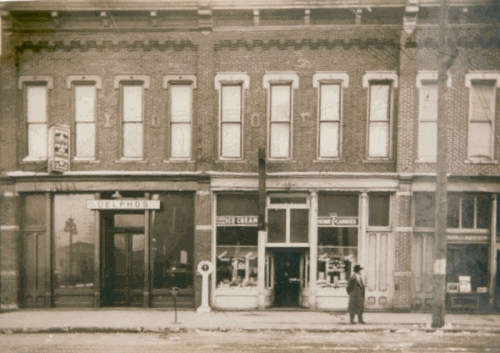
In Delphos, the interurban depot was located on East Second Street.
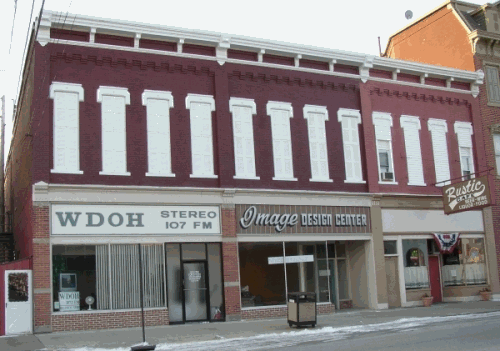
The building of the former depot now houses WDOH offices.
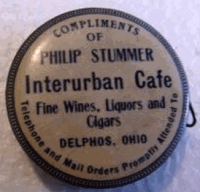
Compiled by Robert Holdgreve
Delphos Historical Society
February 15, 2003 Delphos Herald Newspaper
Technology leads to demise of Interurban Lines
By BOB HOLDGREVE
On Independence Day, 1886 in Lima, horses and mules were liberated.
The first electric car in use west of the Allegheny mountains made its first run in a driving rain storm. It was an amazing sight in those days to see something on the streets, not pulled by horses or mules.
Middletown's Mule Transit
In 1879, C.F. Gunkel started a horse railway, a 1.6 mile route connecting the C.H. & D. railroad depot on the west edge of town with the Big Four line to the east of town.
The company adopted a new name in the 1900s, when it found that mules were capable of doing a superior job. It became the Rapid Mule Transit Traction Co. Mules ate less and were less powerful, but did not need the extra strength to pull Middletown's small cars.
Owners of the company were very happy with the mules and the puffing steam trains kept bringing passengers with nickels to drop in the fare boxes. The tinkling bells on the mules were an added attraction, making it seem like Christmas all yearlong.
The 1913 flood washed away the Third Street Bridge so the line west to the C.H. & D. had to be abandoned and mules now ran only from the Big Four Depot to Main Street.
Horse cars were unheard of in World War I days and travelers stood in amazement as they watched the driver unhitch the mules from one end of the car, and hook the animals up to the other end.
The line became famous, and soon appeared on postcards with the caption "Modern Rapid Transit, Middletown, Ohio."
In 1918, the line was still rolling among hoards of automobiles, strange contrast.
Finally the owners decided to replace the mule cars with busses. The last trek was May 4, 1918. This was probably the last horse car in the United States.
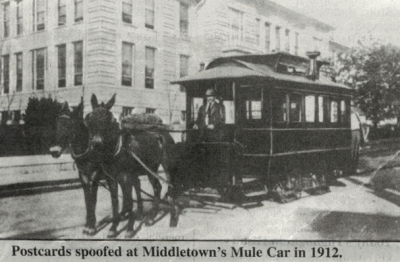
The Miami and Erie Canal Railway
At the turn of the century, Ohio's canal systems were in their death throes. The Miami and Erie was largely used for ice skating in the winter and fishing in the summer. Canal boats were too slow at 2 1/2 miles per hour, as the railroad freight trains whizzed past at 25 mph.
The trolly tow was hailed as the adrenaline that would rescue the declining canal industry. The overjoyed State of Ohio gave its blessing to convert the towpath into a railroad. This was a mammoth job.
The line was opened 42 miles from Cincinnati to Middletown in late 1903. There were seven road locomotives weighing 28 tons with two 80 horsepower electric motors. They were geared for a dragging pull of 6 mph. The road engines had double hooks on each side to secure the barges. The erratic tow path designed for mules, crisscrossed the canal at three points. Here, quick working bridge tenders provided excitement as they swiftly opened the bridge after the locomotive crossed to permit the barges to go unobstructed.
Because of many factors, including washing out the canal banks with waves, instead of 10-barge tows at 6 mph, five barge tows at 3 mph were the maximum.
After a year of look-see operation, the canal tow trolly line was ordered junked. Wreckers removed the valuable copper and iron in 1905, and the three-phase locomotives, unsaleable elsewhere, were junked.
When the Indianapolis, Columbus & Eastern Traction Co. purchased the Columbus & Lake Michigan steam Railroad running from Lima to Defiance, it took on a pathetic railroad, rich. in lore and shattered dreams.
Originally known as the Columbus, Lima & Milwaukee, the line was founded by Ben Faurot, a Lima citizen who was a self-made millionaire. His money pyramided from the sale of mules to the Union Army during the Civil War. He constructed the early electric Lima street car line. Lima was the first city in northwestern Ohio to boast electric power, furnished by Faurot's turbines. He owned paper mills an designed the great Faurot Opera House with 2,000 seating capacity. He donated Woodlawn Cemetery and laid out a ball park. But Faurot's dreams were on railroading.
The line was in planning stages for years, and finally commenced again in 1898.
The line struck northwest from Lima on private-right-of-way, taking dead aim at Defiance It paralleled no roads, running through Kalida and Continental enroute.
On April 10, 1905, regular passenger service started. Then on Feb. 6, 1906, W. Kelsey Schoepf bought the line for a song and incorporated it in the I.C.& E. On Aug. 1, 1909, the first green electric car ran under the Ohio Electric banner. A daily steam train was intermixed with the trollys.
The Lima-Defiance line was sold in 1923 to a Lima group. In 1926, wires were torn down, and a gasoline doodlebug and steam engines took to the rails. In February 1929, notices went up at the stations that the line was temporally abandoned. This meant forever, and the Faurot dream was buried in a tangle of weeds.
Taken from "Ohio Trolly Trails" by Harry Christiansen
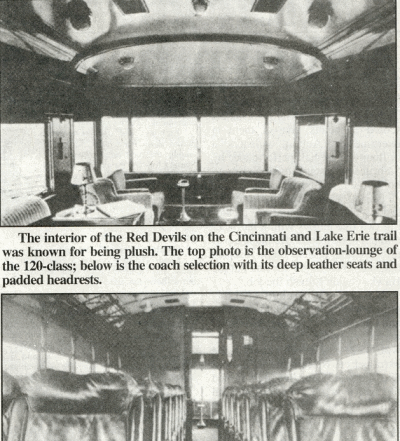
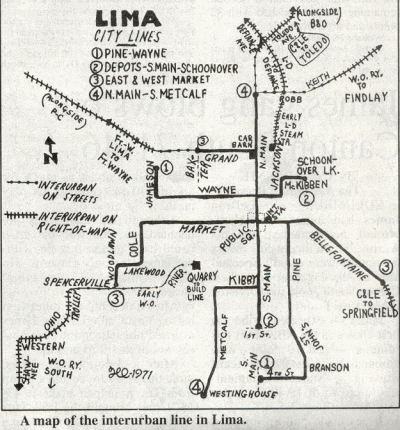
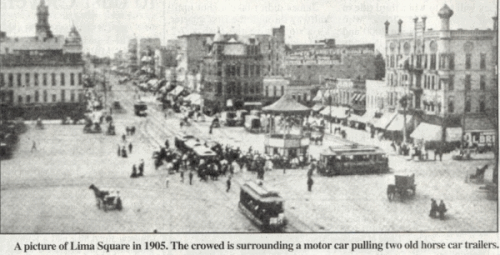
Compiled by Robert Holdgreve
Delphos Historical Society
March 22, 2003 Delphos Herald Newspaper